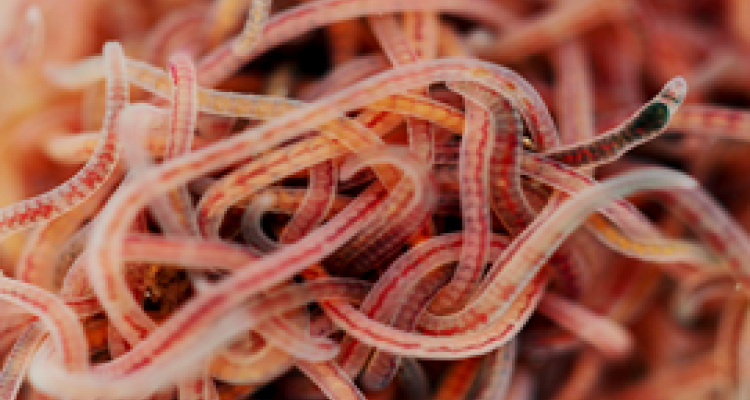
News
Reducing food waste by producing high quality worm biomass
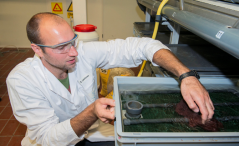
The growing world population requires the production of increasing amounts of proteins, such as meat and fish. As a result, the global aquaculture industry is booming, with a yearly growth of about 8 % per year. Predatory fish, like salmon and trout, are farmed globally at a large scale. These species need high-quality, protein-rich, feed that usually originates from fish-based raw materials. To sustain these expanding fish production activities, there is an increasing need for fish oil and fish meal to produce fish feed. This puts extra pressure on already overharvested wild fish stocks. Therefore, sustainable alternatives for marine oils and proteins to support these growing aquaculture industries are desperately needed.
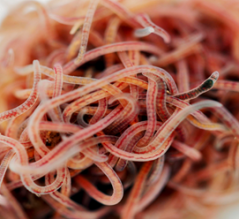
Convert waste
Aquatic black worms (Lumbricus variegatus), may play an important role in replacing fish oil and fish meal in aquaculture feed. These invertebrates have high nutritional values, and for this reason the species is already cultured in ponds in the USA and Australia. But since they are fed with fish-based products, this is not a sustainable solution. However, these versatile creatures may feed on other protein sources as well, for example organic waste. ‘Black worms are not very demanding regarding their food. They feed low in the food chain and may grow on proteins present in waste streams as well’, Laarhoven explains. ‘In this way, they may convert waste into valuable worm biomass.’
In addition, black worms are cold-blooded animals, resulting in a relatively high feed conversion and a low carbon footprint. About 50 % of all protein and about a third of the total organic fraction present in waste streams can be converted into worm biomass. Therefore, these worms are a sustainable alternative for fish-based aquaculture feed. In addition to being efficient, black worms are easy to cultivate: they are tough and due to their a-sexual reproduction they can easily be cultured inside a reactor.

Unpredictable growth
Previous research has shown that black worms grow well on sludge in wastewater treatment plants, where they convert bacterial protein into worm biomass. However, worms growing in these plants accumulate some of the heavy metals present in sludge. In addition, growth is rather unpredictable due to fluctuating wastewater temperatures and nutrients present. Laarhoven focused his research on finding alternative food sources for the worms. He discovered that worms could successfully be cultured on cleaner, food-related, waste streams, for example the protein-rich sludge originating from the potato industries. In addition, he developed a completely new reactor concept to culture black worms in a controlled and predictable way. The original design of the worm-culturing reactor consisted of a cylinder made of cloth. The nutrient-rich waste stream was flowing through this cylinder, while the worms were positioned in such a way that their heads were sticking into the cylinder. ‘We had to improve this concept, because the worm density, growth rates as well as the growth efficiency were too low’, Laarhoven explains. ‘As a result, too much sludge was not utilized by the worms.’
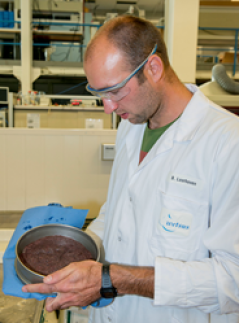
Sustainable replacement
To increase reactor performance, Laarhoven redesigned the original reactor concept. In the new design, the waste stream was now dosed and recirculated through a vertical column made of course sand. Worms positioned themselves in between the sand grains, while their tails were sticking outside the gravel layer, to have both access to nutrients and oxygen as they take up the oxygen by their tails (fig. 2). ‘The worms are now distributed more evenly throughout the whole column’, Laarhoven says. ‘Higher worm densities can now be maintained, while sludge utilization is optimized.’ The new patented reactor produces up to six times more worm biomass per unit of time as compared to the older version and still shows room for further improvement. ‘Even if the worms are fed with plant- or bacterial- based waste, this has no large impact on the composition of worm biomass: it is consistently very similar to fish meal’, Laarhoven says. ’This makes these worms an ideal and sustainable replacement for fish-based aquaculture feed.’
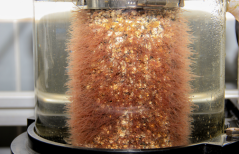
Large worm production
The controlled system now functions very well on a small scale. The reactor is stable: it continuously produces a steady amount of worms. ‘We now need to scale the reactor to a much larger volume’, Laarhoven says. ‘It all looks very promising, but only a future pilot can really prove if this concept can be used for large scale worm production in order to start replacing fishmeal by worm biomass.’ According to the scientist, the commercial success will largely depend on the acceptance of black worms as a safe feed for farmed animals. In addition, the legalization of food waste products to use as feed in worm culturing systems is necessary.
This research was performed at Wetsus within the theme ‘aquatic worms’, supported by Tailtec and Duynie.